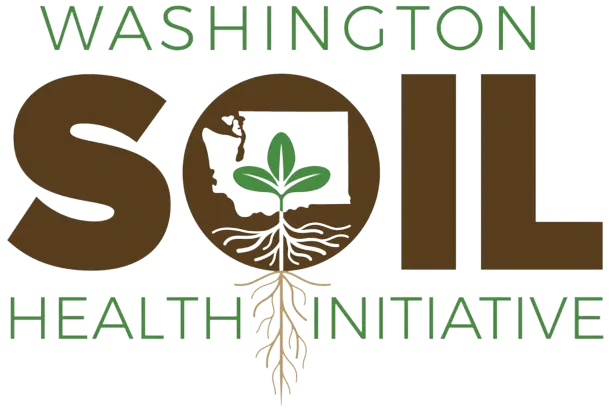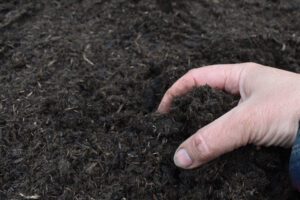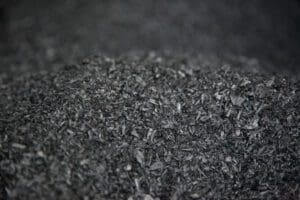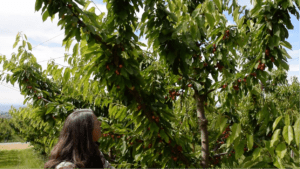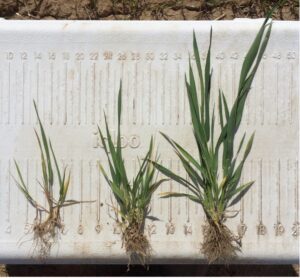
© Si Gao
Locally produced soil amendments: using biochar on the San Juan Islands
Locally produced biochar on the San Juan Islands can improve some soil health properties, while offering local solutions to waste management challenges.
September 5, 2024
Author: Si Gao
Farmers often apply soil amendments like fertilizer or compost to improve their soil fertility and soil health. However, many times the soil amendments must travel many miles to the field. Some farmers create their own compost, which reduces the transportation cost and greenhouse gas emissions from travel. Another soil amendment is also becoming more popular: biochar. During my PhD, I have been exploring the benefits and challenges of using locally produced biochar in the stunning San Juan Islands of Washington state, where local farmers have found success in using biochar in their diversified cropping systems. Biochar, a carbon-rich product derived from organic materials through pyrolysis—heated without oxygen—is gaining popularity for its potential to be a locally sourced soil amendment and its ability to enhance soil health.
Some waste is a soil's treasure
In San Juan County, approximately seventy percent of the land cover is dense secondary forests. Thinning treatments aimed at improving forest health generate forest harvest residues that typically require disposal through pile burning, which creates air quality issues and is costly for landowners. Producing biochar (if done properly, which can be challenging) can reduce smoke emissions and create a second life for these "waste" materials. Importantly, a critical part of San Juan County’s economy is agriculture and organic farming on well drained sandy loam soils. Growing seasons are relatively short and dry due to the “rain shadow” effect created by Olympic Mountains and Vancouver Island. Therefore, biochar production from local timber harvest residues in San Juan County may offer a sustainable means of reducing wildfire hazard fuel loading, while improving soil health and reducing nutrient loss on neighboring organic farms.
Why biochar?
While biochar might sound similar to your go-to grilling charcoal, it's not just any old charcoal; biochar, if created properly, can act like a sponge for nutrients and water, making it a soil health amendment that can impact soil physical properties like water holding capacity. Our research, conducted across multiple organic farms on the San Juan Islands, aimed to uncover the benefits of locally produced biochar, either used alone or in combination with organic fertilizer (i.e., “charged” with poultry litter slurry) on soil nutrient dynamics, focusing on nitrogen and phosphorus, two important macronutrients for plant growth.

FIGURE 1 | The application of locally produced wood biochar to the soil on one of our trial farms on the San Juan Islands. Biochar, which looks like black charcoal, is mixed into the topsoil.
© Si Gao
Our studies on the San Juan Islands
The soils of the San Juan Islands are predominately sandy loam soils formed in glacial till and outwash with a naturally high leaching capacity. The biochar we used was produced on-site by “Cylinder Burn”, chosen for its efficiency by a group of farmers and foresters at Rainshadow Consulting and Northwest Natural Resource Group. Biochar was produced in close proximity to farm sites from logging residues, which, on average, consisted of a mixture of about 80% Douglas fir, 15% White fir, and 5% Western red cedar. Check out more detailed information about the methods in the references below.
Our study of ten organic farms growing dry beans, green beans, and cauliflower explored how biochar application to sandy soils impacts soil nutrient availability. Our experimental treatments were as follows: control (no treatment); biochar (applied at 20 Mg per hectare); poultry litter (applied at 70 Mg nitrogen per hectare); and charged biochar (where biochar was mixed with poultry litter at 20 Mg per hectare + 70 Mg nitrogen per hectare before applying it to the soil). Application rates were chosen to simulate common agricultural practices. The charged biochar treatment was included to provide a biochar pre-loaded with nutrients, possibly enhancing its effectiveness as a soil amendment.
Compared to the poultry litter only, the charged biochar—a combination of biochar and poultry litter—increased soil carbon by 33% and boosted ammonium nitrogen by up to 45%. We also found that the amount of organic nitrogen that can be mineralized—changed into the plant-useable form—throughout the growing season increased to 110% (Figure 2).

FIGURE 2 | Potentially mineralizable nitrogen (PMN) in the soil after applying different treatments: control (no treatment), poultry litter, biochar, and a mix of poultry litter with biochar (charged biochar). The data was collected from ten organic farms on the San Juan Islands, WA. PMN measures the amount of organic nitrogen that soil microbes can convert into forms that plants can use. Higher PMN levels indicate more available nitrogen for plant growth, with charged biochar showing the highest increase.
At the beginning of the season, we also buried ionic resin capsules at the rooting zone to trap nutrients that would otherwise leach down or get lost below the rooting zone. Compared to poultry litter only treatment, we found that charged biochar helped reduced the amount of nitrate and phosphorus that would otherwise get lost below the rooting zone by 28% and 46%, respectively. This means more nutrients available for plants over the growing season.
Boosting soil microbial activity and crop performance
In a deeper dive into biochar’s impact on soil properties, microbial activities, and crop productivity, we partnered with six farms growing Kabocha squash. After one growing season, we found that biochar and charged biochar both significantly improved multiple soil biochemical properties. Either by comparing biochar to control, or by comparing charged biochar to poultry litter, there were significant positive biochar effect on soil carbon content, microbial biomass, bioavailable phosphorus, and activities of phosphatase, β-glucosidase, dehydrogenase, and urease. There was also significant positive biochar effect on multiple soil micronutrients, including iron and zinc, both essential plant micronutrients.
These improvements in soil nutrient availability translated to significant improvements in plant macro and micronutrient concentrations. This comprehensive study demonstrates that biochar, when used with poultry litter, can enhance the overall health and productivity of agricultural soils, making it a valuable tool for sustainable farming.

FIGURE 3 | Kabocha squash growing at one of the trial farms on San Juan Islands, WA.
© Si Gao
Understanding phosphorus dynamics
Soil phosphorus dynamics are more difficult to predict than other nutrients, so our third study focused on how biochar applications may impact phosphorus solubility and availability. We observed a measured increase in soil phosphorus bioavailability, including both active inorganic and organic forms (see Figure 4), along with higher phosphatase activity and microbial biomass in soils treated with biochar. Phosphatase activity is an indicator of microbial involvement in the breakdown of organic phosphorus compounds into inorganic forms that plants can absorb. This suggests that soil microbes in biochar-amended soils became more active and efficient at converting otherwise unavailable organic phosphorus into plant-accessible forms. Additionally, biochar’s porous structure and high surface area help it retain soil moisture (Figure 4) and directly adsorb and retain phosphorus. These properties make biochar an effective tool for enhancing soil fertility by improving phosphorus availability.

FIGURE 4 | Impact of different treatments—poultry litter, biochar, and a combination of both—on various soil properties. The values are response ratios, which indicate how much each treatment increased or decreased the soil property compared to untreated soil (the control, represented by the zero line). A value of 0.5 means the treatment increased the soil property by 1.65 times compared to the control. Red dots represent changes that are statistically significant, and the error bars indicate one standard error, showing the variability of the data. Soil water holding capacity, total C, active inorganic phosphorus (P), organic P, and microbial biomass all significantly improved with both biochar and the combination treatment. The activity of phosphatase, an enzyme that helps release phosphorus from organic compounds in the soil, improved with biochar, poultry litter, and the combination treatment.
Benefits of using biochar as a soil amendment in our study
- Waste Management Solution: Biochar production from timber harvest residues offers a means of reducing wildfire hazard fuel loading while supporting agricultural production.
- Boosting Nutrient Availability: Biochar enhances the availability and retention of crucial nutrients like nitrogen and phosphorus, leading to healthier soils and better crop yields.
- Improving Soil Health: Beyond nutrient availability, biochar can foster a diverse and active soil microbial community, contributing to overall soil health and sustainability.
- Local Solutions: By producing biochar from local timber harvest residues and applying it on neighboring farms, we leveraged local resources for local food production.
General challenges with using biochar
- Nutrient content: Biochar itself contains very few readily available nutrients. If it isn’t properly “charged” with nutrients, it may tie up nitrogen in the soil.
- Biochar composition: Biochar made from hardwoods at high temperatures might be highly stable and effective for long-term carbon sequestration, but it may not provide immediate benefits for soil fertility. While biochar made from softwoods or agricultural waste at lower temperatures might break down more quickly and offer more immediate nutrient benefits but be less effective for long-term soil carbon improvement.
- Particle size: Fine biochar particles mix more easily with soil and provide a larger surface area for interacting with soil nutrients and microbes. However, larger biochar chunks might not integrate well, potentially reducing their effectiveness in improving soil structure and nutrient availability.
These general challenges underscore the need for careful selection of feedstock, controlled pyrolysis conditions, proper nutrient charging, and consideration of particle size when using biochar to ensure it provides the desired benefits for soil health and crop productivity.
Despite these challenges, biochar can still offer significant benefits. Its ability to enhance soil carbon sequestration, reduce soil compaction and nutrient leaching, stimulate microbial activity, and improve water and nutrient retention gives it a "buffering" capacity that helps soils become more resilient. Whether it’s retaining moisture in drought-prone areas, retaining nutrients in sandy soils like the San Juan Islands, or stabilizing carbon in the soil for long-term storage, biochar’s versatile properties make it a valuable tool. Even if the results vary depending on the conditions, the incremental improvements in soil health can contribute to greater overall ecosystem resilience.
Bringing it all together
Our research in the San Juan Islands demonstrates that local biochar is a soil amendment that can improve physical and chemical soil health properties, while offering local solutions to waste management and air quality challenges.
For more details, explore our full publications here:
- Gao, Si, Kai Hoffman-Krull, A. L. Bidwell, and Thomas H. DeLuca. "Locally produced wood biochar increases nutrient retention and availability in agricultural soils of the San Juan Islands, USA." Agriculture, Ecosystems & Environment 233 (2016): 43-54.
- Gao, Si, Kai Hoffman-Krull, and Thomas H. DeLuca. "Soil biochemical properties and crop productivity following application of locally produced biochar at organic farms on Waldron Island, WA." Biogeochemistry 136, no. 1 (2017): 31-46.
- Gao, Si, and Thomas H. DeLuca. "Wood biochar impacts soil phosphorus dynamics and microbial communities in organically-managed croplands." Soil Biology and Biochemistry 126 (2018): 144-150.

Si Gao
Si is an Assistant Professor in the Department of Environmental Studies at California State University, Sacramento. Her research focuses on the impacts of sustainable agricultural practices on soil health and explores how fire and charcoal influence soil carbon and nutrient cycling.
This article was published by the Washington Soil Health Initiative. For more information, visit wasoilhealth.org. To have these posts delivered straight to your inbox, subscribe to the WaSHI newsletter. To find a soil science technical service provider, visit the Washington State University Extension website or the Washington State Conservation District website.

